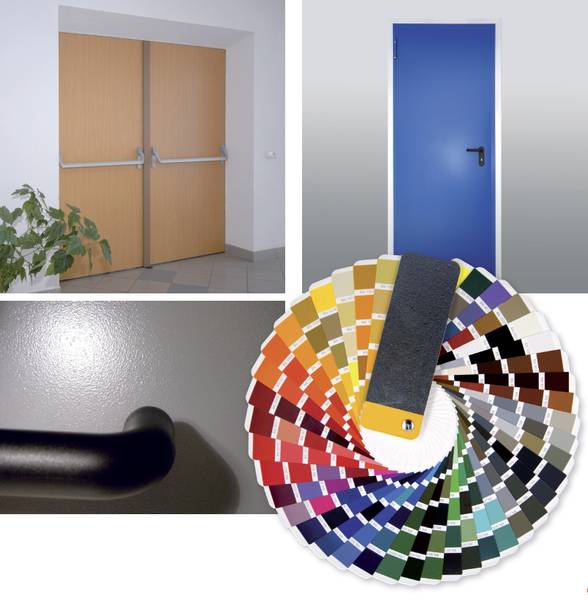Finishing
Finishing
The doors are factory varnished with a 2-component resin-based finish. The standard tone is grey RAL 7035 semi-brilliant embossed. All tones in the RAL range are available to order except the following:
- metallised: 1035 – 1036 – 2013 – 3032 – 3033 – 4011 – 4012 – 5025 – 5026 – 6035 – 6036 – 7048 – 8029 – 9006 – 9007 – 9022 – 9023
- brilliant-luminous: 1026 – 2005 – 2007 – 3024 – 3026.
NCS tones are also available on request.
RESISTANCE OF THE VARNISH TO ATMOSPHERIC AGENTS
LOCHER special varnishes fade slowly and are strongly water-resistant. The fading time varies according to the intensity of exposure to sunlight, the degree of humidity, the presence of salinity and the chosen tone (type of pigment): on average, this takes two years compared directly to doors that have not been left exposed or to the other side of the door itself. If possible, canopies or cantilever roofs can be installed to reduce weather effects and thus varnish deterioration. Doors with fire-rated glass must never be installed on exteriors as water and sunlight can damage them within a short space of time.
CLEANING
For regular cleaning of varnished surfaces, use neutral detergents and smooth, non-abrasive, non-scratching cloths or sponges. Never use pure solvents or nitro thinners, acetone, products with strong ethyl alcohol, limonene or glycol concentration. If you are not sure about the detergent, rub it vigorously with a white cloth on a place that is not highly visible and check that the cloth does not stain the door colour. Wet the glasses only on the surface, never along the cut edges.
SMALL RETOUCHES
The door colour tone can be retouched by means of synthetic, solvent, or water-based varnishes with a small brush or nitro-acrilic spray cans, readily available in paint shops. Retouches will never be perfect owing to the finishing type and the colour tone tolerance. Wiping the retouches with polish can improve the final result. If there are numerous or major retouches, varnish the complete door again.
MANUAL REPAINTING
To manually repaint doors that have been finished with factory paint, sand the surfaces of leaves and frames with abrasive paper (grain 260 or thinner). Dustclean them with a cloth or compressed air. Repaint the door in the desired tone by means of a spray, brush or roll using epoxy, polyurethane or synthetic varnish, water-based or with rapid-dry solvent.









